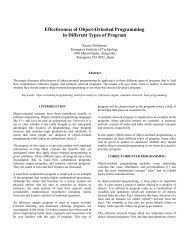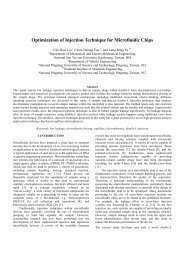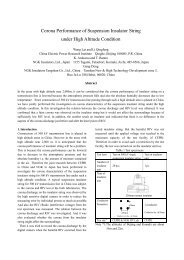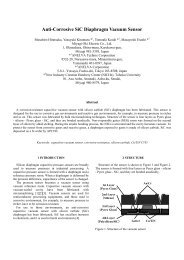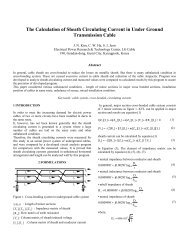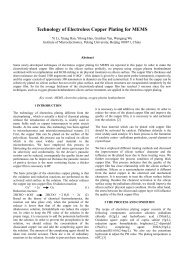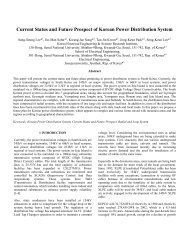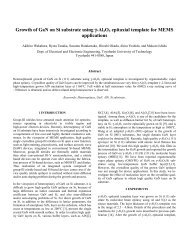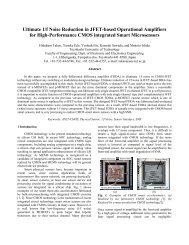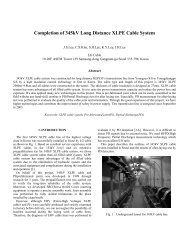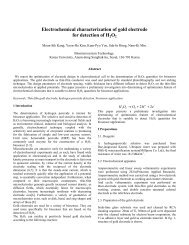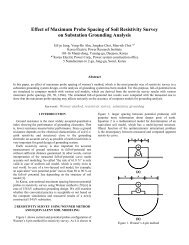Suppression of Microwelding in RF MEMS Direct Contact Switches
Suppression of Microwelding in RF MEMS Direct Contact Switches
Suppression of Microwelding in RF MEMS Direct Contact Switches
Create successful ePaper yourself
Turn your PDF publications into a flip-book with our unique Google optimized e-Paper software.
the resistive loss <strong>of</strong> the signal l<strong>in</strong>e which <strong>in</strong>cludes theresistance <strong>of</strong> the signal l<strong>in</strong>e and the contact resistance. Athigher frequencies, the <strong>in</strong>sertion loss can be attributed to boththe resistive loss and the sk<strong>in</strong> depth effect [3-4].micromach<strong>in</strong><strong>in</strong>g technique with a total <strong>of</strong> six basic mask<strong>in</strong>glevels. Gold sputtered us<strong>in</strong>g <strong>RF</strong> magnetron sputter<strong>in</strong>g systemis used as the structural material and AZ1512 photo resist isused as the sacrificial material. Figure 5 is an abbreviatedcross sectional schematic illustration <strong>of</strong> the process sequence.Fig. 3 Insertion loss, return loss and isolationsimulated by HFSS v8.0.Section AA’Section BB’Port 1(a) CPW l<strong>in</strong>e patter<strong>in</strong>g with dimples (W or Mo)and dielectric layer pattern<strong>in</strong>g (SiN)Port 2 Port 3Fig. 4 Switch Pattern for S-Parameter Simulation.We made short circuit between port 1 and port 2,while port 1and port 3 are open circuit with gold dimple switch (Fig. 4).Insertion loss will be <strong>in</strong>creased slightly when W or Mo dimplewas used. However, this value can be ignored because <strong>of</strong> lowloss characteristic <strong>of</strong> the switch.(b) Sacrificial layer sp<strong>in</strong> coat<strong>in</strong>g and anchor pattern<strong>in</strong>g(c) Thermal treatment for sacrificial layerand Au cantilever pattern<strong>in</strong>g4 FABRICATION4.1 Overall Process<strong>RF</strong> <strong>MEMS</strong> switches were fabricated based on the conventionalsemiconductor manufactur<strong>in</strong>g process. A coplanar waveguideis a planar transmission l<strong>in</strong>e made up <strong>of</strong> a center conductorseparated by gaps the ground planes on either side. Thecharacteristic impedance <strong>of</strong> the coplanar waveguide is set bythe width <strong>of</strong> the center conductor, the width <strong>of</strong> the gap, and therelative permittivity <strong>of</strong> the substrate. Upon the application <strong>of</strong> asufficiently large voltage between the actuation cantilevers andelectrodes, the cantilevers collapses downward until itconforms to dielectric layers, which prevents it from short<strong>in</strong>gto the ground plane.<strong>MEMS</strong> switch is manufactured us<strong>in</strong>g a surface(d) Connect<strong>in</strong>g bar pattern<strong>in</strong>g (stress controlled SiN)Fig. 5 Fabrication process for <strong>RF</strong> <strong>MEMS</strong> Switch.4.2 Stress control <strong>of</strong> connect<strong>in</strong>g barThe performance <strong>of</strong> <strong>MEMS</strong> devices is still significantlyrestricted by residual stress <strong>of</strong> th<strong>in</strong> films (Fig. 6). To reducethe effect <strong>of</strong> the total stress <strong>in</strong> released structures, manyapproaches were proposed and successfully demonstrated[6–8]. They used additional stress compensation layers and
suitable mechanical designs.Fig. 6 Deformed shape after <strong>in</strong>duc<strong>in</strong>g residual stress.In this study, we controlled residual stress <strong>of</strong> silicon nitride(SiN) layer formed by PECVD (Plasma Enhanced ChemicalVapor Deposition). It has been demonstrated that the residualstress <strong>of</strong> SiN is affected by the frequency used <strong>in</strong> PECVDprocess. In case <strong>of</strong> the low frequency (i.e. 50~100 kHz), morethe ions <strong>in</strong> the plasma are able to oscillate accord<strong>in</strong>g to thealternat<strong>in</strong>g electric field, and hence, transfer energy to thegrow<strong>in</strong>g SiN film, caus<strong>in</strong>g a densification. For this reason, theSiN film is compressively stressed aga<strong>in</strong>st the substrate.Figure 7 shows curved SiN film used for connect<strong>in</strong>g bar withcompressive residual stress, which is undesirable for metalcontact.In case <strong>of</strong> high frequencies (i.e. 13.56 MHz), not all the ionscan follow the alternat<strong>in</strong>g field, and thus, the SiN filmbecomes less dense and tensely stressed aga<strong>in</strong>st the substrate[2]. Figure 8 shows SiN film used for connect<strong>in</strong>g bar withtensile residual stress. The SiN film was formed by us<strong>in</strong>g onlyhigh frequency <strong>in</strong> PECVD Process.5 EXPERIMENTAL RESULTSTo exam<strong>in</strong>e the dynamic behavior <strong>of</strong> <strong>MEMS</strong> switch test. Anamplified function generator signal for device actuation andmulti-meter to monitor contact resistance are required. S<strong>in</strong>ewave with peak amplitude <strong>of</strong> 20 ~ 40 Volts is applied. Theelectrostatic force on the <strong>MEMS</strong> switch is proportional to V 2 ,and therefore a bipolar voltage will always result <strong>in</strong> a constantattractive force on the cantilever. And bipolar actuationresulted <strong>in</strong> a vast improvement <strong>in</strong> the reliability <strong>of</strong> the L<strong>in</strong>colnLaboratories and the University <strong>of</strong> Michigan switches. Andreliability can be improved by tailor<strong>in</strong>g the actuation voltagewaveform to reduce the impact energy and the result<strong>in</strong>g pitt<strong>in</strong>gand harden<strong>in</strong>g <strong>of</strong> the contact area. This was demonstrated byRockwell Science Center and University <strong>of</strong> Michigan [9]. Inthis case, s<strong>in</strong>e wave (Fig. 10) with peak amplitude <strong>of</strong> 20~40Volts are applied which can <strong>in</strong>clude bipolar and tailor<strong>in</strong>g theactuation voltage <strong>in</strong> Figure 9.VoltageVoltageTimeTime(a)(b)Fig. 9 (a) bipolar, and (b) tailored actuation voltages.VoltageTimeFig. 10 S<strong>in</strong>e waveform actuation voltage.Fig. 7 Compressively stressed silicon nitride film (200 MPa).<strong>Contact</strong> resistance was measured by us<strong>in</strong>g probe station andfunction generator at atmospheric pressure. The results showedthat the resistance <strong>of</strong> gold-on-gold contacts was between 0.2and 1.9 Ω and gold-on-tungsten contacts was 2 times as highas that <strong>of</strong> gold-on-gold contacts. It means if tungsten is usedfor switch dimple the <strong>in</strong>sertion loss will be -0.4 ~ -0.2 dB [1].6 FUTURE WORKFollow<strong>in</strong>g tests with three types <strong>of</strong> switches will be done bythe end <strong>of</strong> April, which have different contact materials: Au,W, Mo.Fig. 8 Tensely stressed silicon nitride film (50MPa).6.1 <strong>RF</strong> power handl<strong>in</strong>g testThe maximum power-handl<strong>in</strong>g capability <strong>of</strong> three k<strong>in</strong>ds <strong>of</strong>switches with different contact material will be evaluated atseveral GHz frequency range.
6.2 Insertion loss and isolation testInsertion loss and isolation will be evaluated for three k<strong>in</strong>ds <strong>of</strong>switches.6.3 Lifetime test.The lifetime <strong>of</strong> the switches will be evaluated at several GHzfrequency range.7 CONCLUSIONWe have made an attempt to suppress the <strong>in</strong>-use stiction <strong>in</strong> <strong>RF</strong><strong>MEMS</strong> direct contact switches due to microweld<strong>in</strong>g. Twok<strong>in</strong>ds <strong>of</strong> refractory metals, W and Mo, were coated onto thecontact po<strong>in</strong>t <strong>of</strong> the switches and the effect <strong>of</strong> refractory metalscoat<strong>in</strong>g was <strong>in</strong>vestigated. The results showed that refractorymaterials have higher contact resistance than gold. Eventhough higher contact resistance <strong>of</strong> refractory metals isdetrimental to <strong>in</strong>sertion loss, the use <strong>of</strong> refractory metals isexpected to do good on power handl<strong>in</strong>g capability and lifetimeextension.The <strong>in</strong>sertion loss, isolation and lifetime for three types <strong>of</strong>switches will be evaluated by the end <strong>of</strong> April.REFERENCES[1] G. Rebeiz, J. Muldav<strong>in</strong>, “<strong>RF</strong> <strong>MEMS</strong> <strong>Switches</strong> and SwitchCircuits”, IEEE Microwave Magaz<strong>in</strong>e, pp.59-71, 2001[2] A. Tarraf, J. Daleiden, “Stress <strong>in</strong>vestigation <strong>of</strong> PECVDdielectric layers for advanced optical <strong>MEMS</strong>”, J. <strong>of</strong>Micromechanics & Microeng<strong>in</strong>eer<strong>in</strong>g, 14, pp317-323, 2004[3] J. Jason Yao, M. Frank Chang, “ A surface micromach<strong>in</strong>edm<strong>in</strong>iature switch for telecommunications applications withsignal frequencies from DC up to 4GHz”, The 8 th InternationalConferences on Solid-State Sensors and Actuators, 1995[4] J. Jason Yao, “<strong>RF</strong> <strong>MEMS</strong> from a device perspective”, J. <strong>of</strong>Micromechanics & Microeng<strong>in</strong>eer<strong>in</strong>g, 10, pp9-38, 2000[5] Tarn, H. William, “CRC Handbook <strong>of</strong> metal etchants”,CRC Press, 1991[6] F. R. Gass, D. J. Dagel, D. P. Adams, G. D. Grossetete, O.B. Spahn, S. A. Kemme, S. S. Mani and K. J. Malloy, “Stressand curvature <strong>in</strong> <strong>MEMS</strong> mirrors”, Proc. SPIE, 4983,pp87–93, 2003[7] M. T. Hou, K. Liao, H. Yeh, B. Cheng, P. Hong and R.Chen, “Fabrication <strong>of</strong> micromach<strong>in</strong>ed focus<strong>in</strong>g mirrors withseamless reflective surface”, Proc. SPIE, 4983, pp59–66, 2003[8] J. J. Taghander, “Shape control and heat transfer <strong>in</strong> optical<strong>MEMS</strong>”, IEEE LEOS Newsletter, 16, pp3–8, 2002[9] G.Rebeiz, “<strong>RF</strong> <strong>MEMS</strong> Theory, Design, and Technology”,Wiley Interscience, 2003



